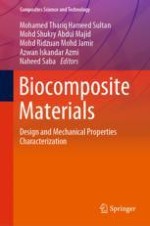2021 | Book
Biocomposite Materials
Design and Mechanical Properties Characterization
Editors: Dr. Mohamed Thariq Hameed Sultan, Dr. Mohd Shukry Abdul Majid, Dr. Mohd Ridzuan Mohd Jamir, Dr. Azwan Iskandar Azmi, Dr. Naheed Saba
Publisher: Springer Singapore
Book Series : Composites Science and Technology
